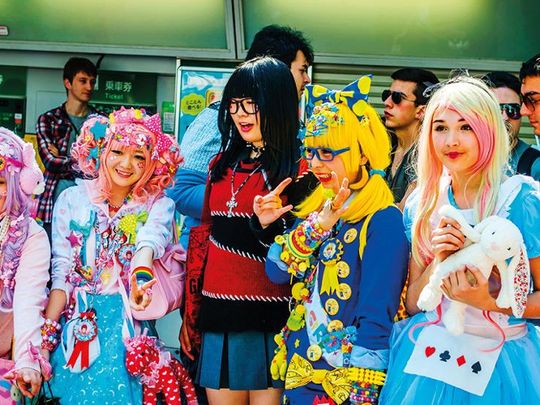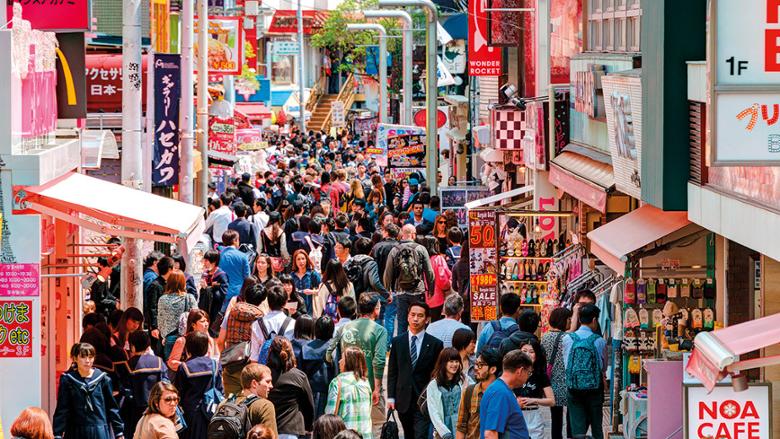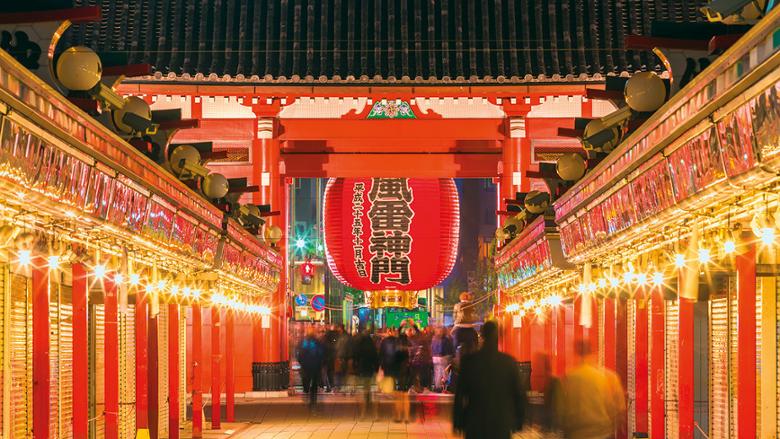
My middle daughter, Bliss, in her early 20s, moved out in a huff. We were having rows and now I can’t remember what they were about; probably about her needing her independence. When she visited, we began talking again – but I could feel the thaw.
Out of the blue I said: "Let’s go to Japan." It just came to me. My children are used to my mad travel ‘arrangements’. When they were little I used to tell them to pack their bags and we would sit in front of Teletext (remember that?) and bag a bargain. We would literally go that day or the next. Crete all-in for £100! Ever since they were tiny, I have taken them all over the world.
"Isn’t Japan super-expensive, though?" Bliss said. I rang up a tour operator and it was indeed a lot of money. I didn’t even know that it was cherry blossom season, but I thought "I am a woman of the world. I can do better than that." So I did, bagging a couple of cheapish flights, changing in Vienna, and then telling her we were off to Tokyo. On a budget."
"OMG. OMG Mum, are we really going?" Bliss asked.
We were indeed, and people gave me lots of unwanted advice. "It’s so expensive and you will get lost all the time." Neither of these things turned out to be true.
What no one realised is that our budget meant we’d be in tiny lodgings, because space is at a premium in Tokyo. Neither of us is small. Two fat birds in teeny-weeny rooms; it could all go very wrong...

Yet from the minute we arrived and tried as best as we could to squash ourselves into the intricate way the Japanese do everything, the more we bonded in sheer wonder. The bus driver bowed, someone bowed to the bus, and we were still only at the airport, having gone through finger-printing, eye-scanning, the works.
I had picked a mid-price hotel near Shinagawa station. As Tokyo is so massive, you really have to treat it as a series of small towns that you will visit separately. The Shinagawa Prince was fine in its huge, thousands-of-rooms way. It was its own world of things you never knew you needed in a hotel. Like a dolphinarium, indoor golf, a bridal shop, a wig place, an 11-screen cinema and a curry buffet.
We didn’t need any of that, as the minute we went out we discovered supermarkets that sold the freshest sushi and so many other marvels. We ate mostly supermarket food and had one meal out a day. My daughter still has the boiled egg in a can she bought – she fell in love with the packaging.
Both of us had been left smitten by an androgynous boy band that appeared everywhere, and a TV show in which the prize was a steak eaten by giggling girls. None of it made sense. The first thing you learn is to stop trying to make Japan fit into your preconceptions and just try not to offend theirs. That in itself is difficult.
We headed first to the Harajuku district, for two things: the Meiji Shrine, and fashion. The subway is easy to negotiate, it arrives on time – to the second – and people are helpful, although there was an embarrassing moment when one man we asked didn’t know the way and burst into tears.
Harajuku is where you see the inimitable style of the young Japanese: the harajuku girls, who dress as ultra-feminine Goth dollies. Given the reality of Japanese women’s lives (many choose not to marry and have children because they don’t want lives of subservience), this isn’t really my thing.
Much more up my street was the mix of high-end designer gear with DIY punk style that these kids customise. Then, of course, there are the people who wear the outfits of jobs they don’t do – like the man who hangs out dressed as a plumber, but is not a plumber. It would take a lifetime to explore these intertwining subcultures but it’s all massively fun.
Compact, quiet, ordered
Tokyo is not a place to wander around. Sure, go look at the Shibuya Crossing but know where you want to end up. Bliss was drawn into a shop with puppies and kittens in the window, so in we went to be confronted by sleazy stuff. Things are not what they seem.
We easily worked out tickets for the bullet train to Kyoto. As we sat there, in our usual disarray, the man next to us got out his napkin, his bento box and a drink. Gosh, I thought, we are such a mess compared with these compact, quiet, ordered people.
Sometimes they let us know that. My daughter has blonde curly hair, lovely ringlets. An old lady on the subway gestured to me and a young man translated. She was letting me know that I could get some scissors and cut off all her hair. I tried to explain that she would never have black, straight beautiful Japanese hair, but to no avail.
Kyoto, with its wooden houses, was quieter than Tokyo but felt more touristy in many ways. We walked through the Arashiyama Bamboo Grove, which was like being in a painting of a dream. We glimpsed geishas scuttling along but we didn’t get dressed up as them, which is an option. I wondered if they would have any kimonos big enough.
Dinner was a challenge. They gave us lots of ingredients and a griddle, and we were dumbstruck. This was okonomiyaki, where you choose the ingredients for a savoury pancake yourself. It took us a while to cotton on to the fact that each restaurant does its own thing. Ramen or tempura. Slurping is encouraged, soy sauce is not.
The best meal we had was when we found a tiny place and there was no menu. We got what we were given, in this case some sort of burger.

Later, a professor, a lovely man, sat and had tea with us and told us about what happens when he accompanies his students to Europe. Switzerland they can cope with, because it’s clean and punctual; England was somewhere they had seen in films, so was familiar; but Italy – with people randomly shouting and nothing happening on time – was hard for them.
Back in Tokyo, we met up with Mi-key, with whom Bliss had been to school. He is Jamaican, with a Japanese grandad, and had always said he would live in Japan. The kids had laughed but here he was, living in Tokyo and speaking fluent Japanese. Walking around with him was an eye-opener. While Bliss went out with him, I sat in a cafe happy to have a breather – but they put a huge, stuffed toy in the seat opposite, so I wouldn’t feel alone. Sitting facing a huge rodent made me feel self-conscious to say the least.
We were now staying in a different area of Tokyo, in a traditional ryokan. The room was the size of a postage stamp, with the traditional tatami mats and an onsen (hot spring) on the roof. Bliss wouldn’t go in that, as it involved getting naked with me: ‘disgusting’.
We were right by the Asakusa shrine, where there is a bustling market. Across the bridge is the famous Phillipe Starke building, the Asahai Beer Hall. Local people refer to it as ‘the golden turd’, but I grew to like it. We spent a lot of time in the market, where I queued for anything the locals did because it was inevitably delicious. We also got told off by several old ladies because, when we were trying to buy a geisha outfit for my friend’s pug, we didn’t know the dog’s weight.
How elderly live
It is striking in Japan that old people are nimble and everywhere and part of life. Indeed, one of the reasons we spent a lot of time in the market was because, when the ladies came to clean our room, they would not let us back in again for five hours. Were we that filthy? To them, probably. Also, we just could not do the breakfasts: fish with a raw egg on top.
My favourite day was when we went to the Issey Miyake museum. The building itself folds extraordinarily, and I thought it would be about clothes. It turned out to be an entire exhibition about rice. Rice is sacred. Watching a film about rice farmers talking about how many harvests they would see, and how they must die having returned the land in better condition than they found it, was profoundly moving. Japanese people go out of their way to buy rice from their own prefecture. I found myself weeping at the beauty and humility of it all.
We came out into the pinkest blossom. It was magical.
There was one more thing to do. I had heard that Alcatraz ER – a ‘prison hospital restaurant’ – was a blast. We sat in a bar, trying to eat the shark cartilage snacks they had given us, and had difficulty working out where it was.
The waiter walked us there, a good 15 minutes away. We went up a tower block, pressed a button and were asked for our blood type, then we were taken into the dark and put in a prison cell. A nurse in rubber gear syringed beverages into our mouths. Then it all went black and people started screaming and getting slapped.
"Mum, I don’t like this!" Bliss said, anxiously. Then they set the floor on fire. Wow! It was certainly a night to remember.
We ran out laughing and screaming and holding on to each other. Here we were, back together again, in this strange and wonderful country. We had but grazed the surface of its culture but, somehow, being somewhere so unknown had pushed us closer. We had to get to know each other again, as adults – and as we fell in love with Japan, we realised we also liked each other.






